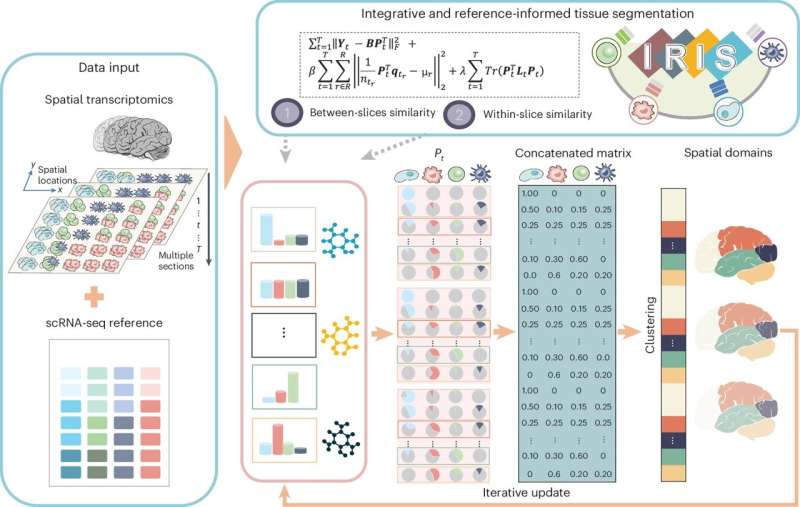This article has been reviewed according to Science X's editorial process and policies. Editors have highlighted the following attributes while ensuring the content's credibility:
fact-checked
peer-reviewed publication
trusted source
proofread
Novel AI method could improve tissue, tumor analysis and advance treatment of disease

Researchers at the University of Michigan and Brown University have developed a new computational method to analyze complex tissue data that could transform our current understanding of diseases and how we treat them.
Integrative and Reference-Informed tissue Segmentation, or IRIS, is a novel machine learning and artificial intelligence method that gives biomedical researchers the ability to view more precise information about tissue development, disease pathology and tumor organization.
The findings are published in the journal Nature Methods.
IRIS draws from data generated by spatially resolved transcriptomics and uniquely leverages single-cell RNA sequencing data as the reference to examine multiple layers of tissue simultaneously and distinguish various regions with unprecedented accuracy and computational speed.
Unlike traditional techniques that yield averaged data from tissue samples, SRT provides a much more granular view, pinpointing thousands of locations within a single tissue section. However, the challenge has always been to interpret this vast and detailed dataset, says Xiang Zhou, professor of biostatistics at the University of Michigan School of Public Health and senior author of the study.
Interpreting large and complex datasets is where IRIS becomes a helpful tool—its algorithms sort through the data to identify and segment various functional domains, such as tumor regions, and provide insights into cell interactions and disease progression mechanisms.
"Different from existing methods, IRIS directly characterizes the cellular landscape of the tissue and identifies biologically interpretable spatial domains, thus facilitating the understanding of the cellular mechanism underlying tissue function," said U-M doctoral alum Ying Ma, assistant professor of biostatistics at Brown University, who helped develop IRIS.
"We anticipate that IRIS will serve as a powerful tool for large-scale multisample spatial transcriptomics data analysis across a wide range of biological systems."
Zhou and Ma applied IRIS to six SRT datasets and compared its performance to other commonly used spatial domain methods. Ultimately, as SRT technology continues to grow in popularity and use, the researchers hope to see methods like IRIS help to potentially develop targets for clinical interventions or drug targets, improving personalized treatment plans and patient health outcomes.
"The computational approach of IRIS pioneers a novel avenue for biologists to delve into the intricate architecture of complex tissues, offering unparalleled opportunities to explore the dynamic processes shaping tissue structure during development and disease progression," Zhou said.
"Through characterizing refined tissue structures and elucidating their alterations during disease states, IRIS holds the potential to unveil mechanistic insights crucial for understanding and combating various diseases."
More information: Ying Ma et al, Accurate and efficient integrative reference-informed spatial domain detection for spatial transcriptomics, Nature Methods (2024). DOI: 10.1038/s41592-024-02284-9

















